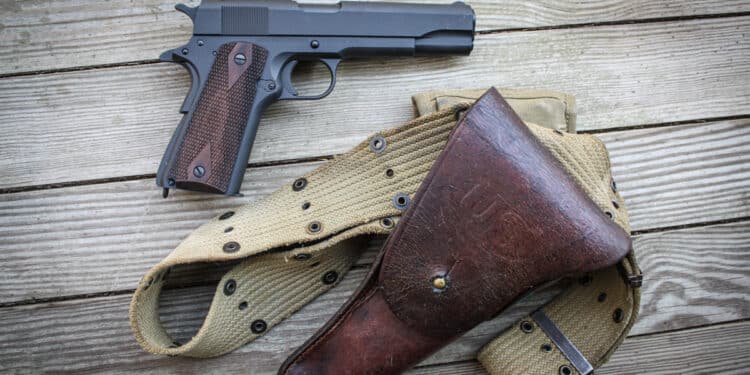Upon picking up the Tisas 1911A1 ASF U.S. Army 45, I learned the guys at the gun counter at Reeves Ace Hardware gave it a good inspection with an eye towards picking up a few for their shop’s inventory. They seemed pleased with it. This M1911A1 is a good example of a high-quality product offered at a low price. SDS Imports and Tisas USA, a veteran owned company, developed the CNC program here in the U.S. then had the gun made to their specs in Turkey, where highly skilled labor is very cheap. They put an American quality control officer in the Turkish factory to make sure their standards were adhered to. TISAS chose to replicate the WWII G.I. 45 Remington Rand M1911A1 with its legendary reliability, and all components are interchangeable with the original. This sits very well with me, as I have always carried a Remington Rand M1911A1 and prefer this make to all others. The famous gun designer Max Atchisson was right when he said, “Typewriter companies make the best guns.” That has proved true for me over many years.
The Tisas slide and frame are made of 4140 steel forgings and the barrel is cold hammer forged. This fact alone makes this gun superior to most of its competitors, as they tend to use milled parts or investment castings which lack the strength of forgings. If an airplane or a bridge is found to not use forgings in a part where a forged part is specified, the government will condemn that airplane or bridge. That’s how serious a matter this is. When lives depend on a part not failing then you need a forging.
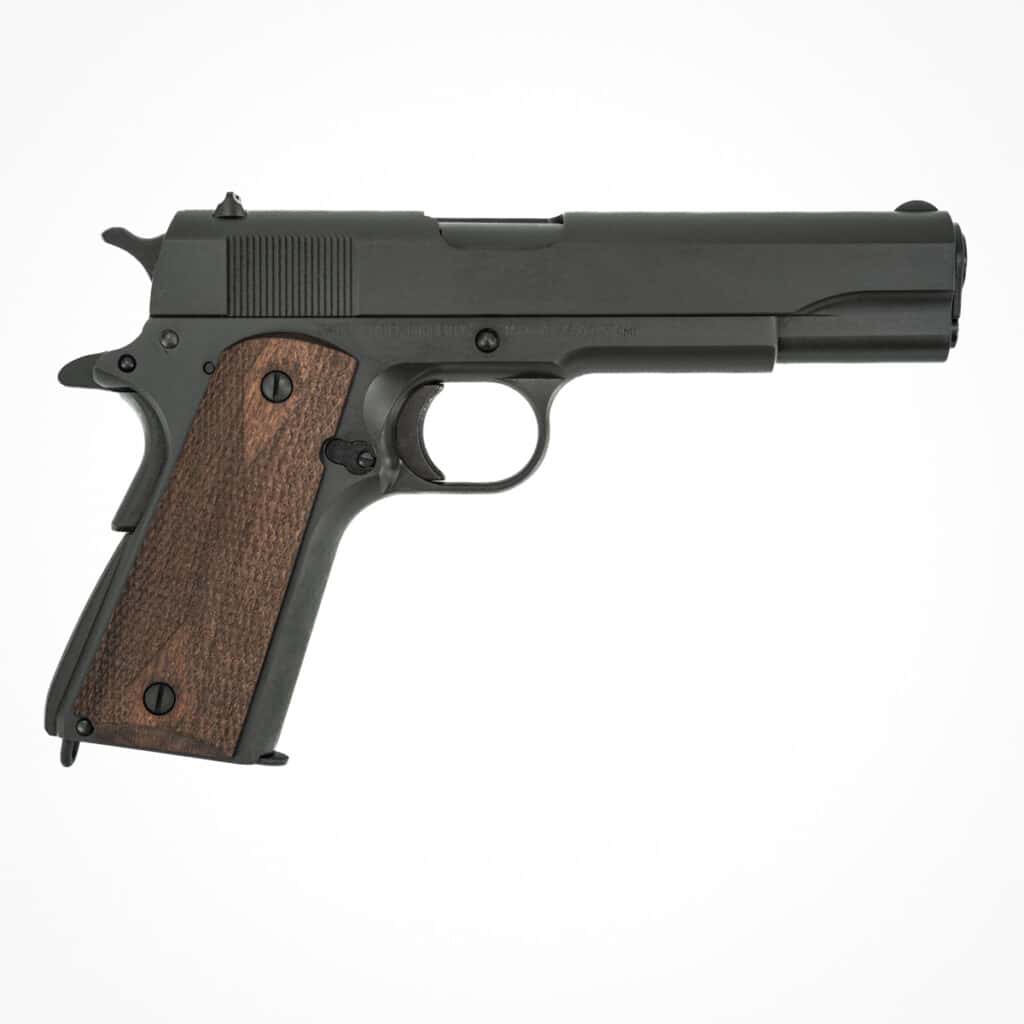
The finish is WWII magnesium phosphate Parkerizing. There are no tool marks, and everything is properly polished before Parkerizing. The fit of the parts is as it should be. Not too tight where it needs room for dust, sand, and mud yet just tight enough where it’s important for accuracy without being too tight. These guns shoot 2-inch groups from a Ransom Rest at 35-40 yards, yet they are loose enough to handle sand and mud without malfunctioning. The trigger pull is a crisp, but heavy, 8 pounds. Thanks to this combination of American know-how and cheap foreign skilled labor, the MSRP is $480… and some dealers offer it for as low as $379. The Civilian Marksmanship Program has also bought these to sell at their outlets. These guns are marked CMP. That’s a hefty stamp of approval.
I had 100 rounds of Black Hills 230-grain FMJ, 100 rounds of Black Hills 230-grain JHP, and 40 rounds of Steinel Ammunition 230-grain SCHP (solid copper hollow point) for a total of 240 rounds to test fire in this pistol. They all ran through the pistol perfectly.
ORIGINAL G.I. VERSION
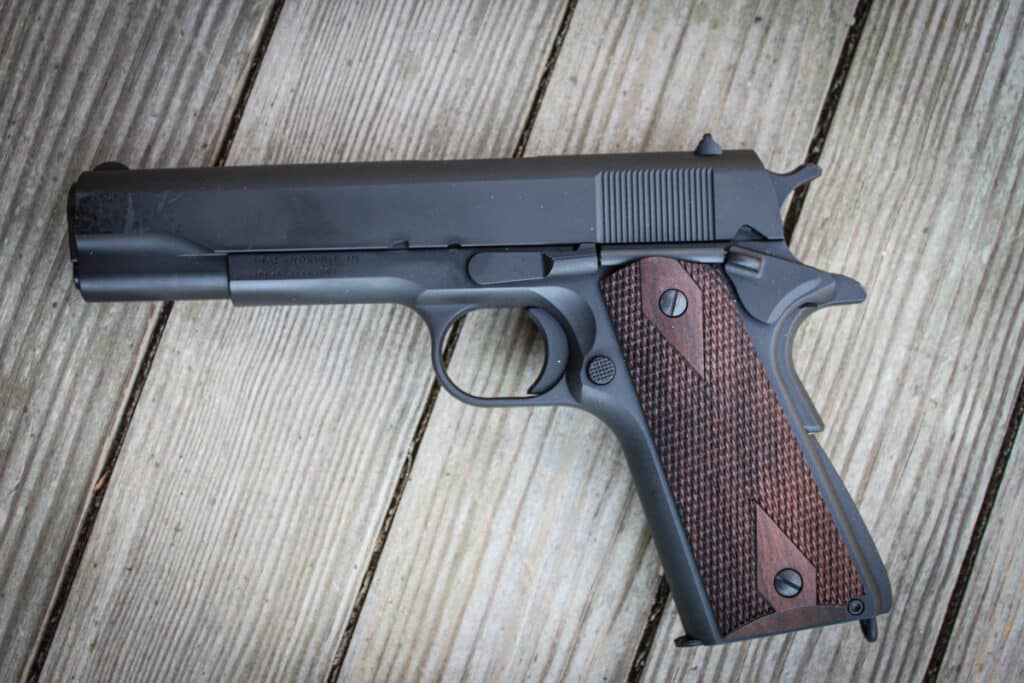
The M1911A1 I tested is the old faithful G.I. version of the gun. The M1911A1 is a combat gun designed to work in the sand and mud of the battlefield. Attempts to improve it with so-called “combat accuracy jobs” and every bell and whistle a conniving marketer can think of just take it that much further from what it was meant to be. A gun that you can stake your life on in the worst battlefield conditions. A good example of how far a match gun is from the original was a top pistol match shooter who told me that he regarded his National Match .45 as a precision target tool and not as a practical gun for the real world. So-called “combat” matches are very far removed from the realities of brutally intense combat where you and your pistol may end up crawling in the sand and muck while having the same stuff blown onto you at high velocity by exploding shells. This is no place for a gun tricked out for combat matches. This is the real world of combat, and it’s down and dirty. Yet, the G.I. M1911A1 takes it in stride and excels when lesser pistols quit functioning. For 113 years, the M1911 has forged a reputation as the most reliable military pistol there is.
WHY THE M1911A1 IS THE MOST RELIABLE PISTOL IN THE WORLD
A gun made from robust parts it is easily rebuilt when it ages and normally lasts 250,000 rounds. This is in sharp contrast to many of the most famous newer pistols which often are reduced to junk after a tenth of that round count. Plastic and sheet metal guns do not lend themselves to rebuilding easily, as well. It’s often cheaper to buy a new gun than rebuild one of the newer models. If your modern, short-lived gun comes to its end in battle and decides to quit on you, then you are screwed. Normal service testing in WWII was to choose a random 1911 from a new production lot and fire 10,000 to 15,000 rounds through it and expect no malfunctions with all the parts still in good serviceable condition at the conclusion of the firing schedule. It was then cleaned and shipped off for issue with the rest of the lot.
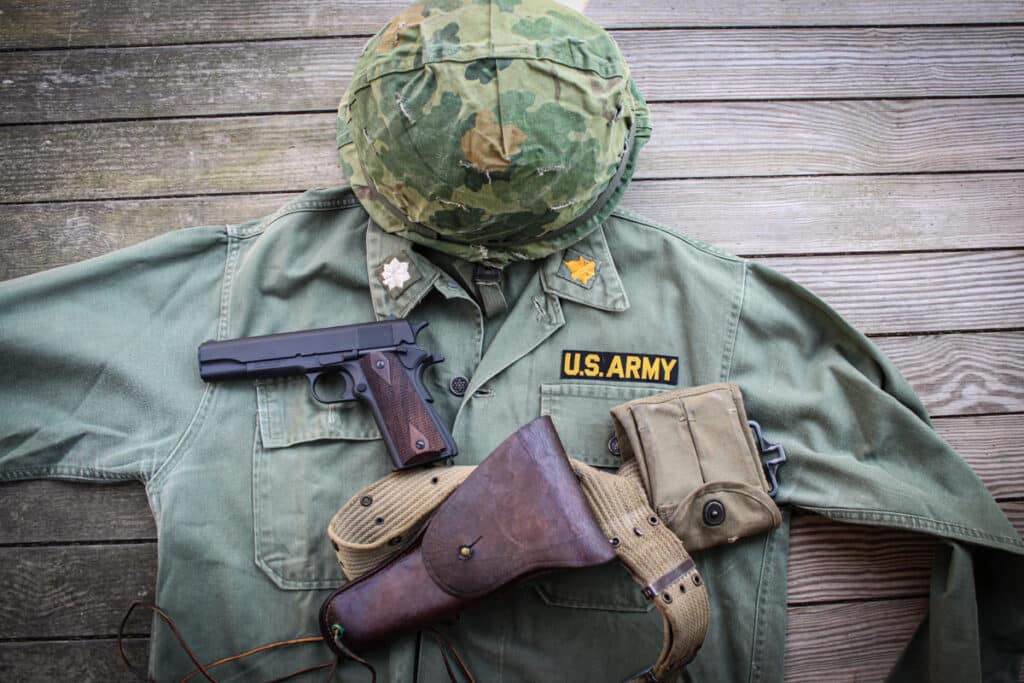
Key to the M1911A1’s reliability is the fact that it’s one of few guns that’s really good at throwing sand and dirt out of the mechanism as it fires. There are also places where dirt can be shoved aside within the gun without causing malfunctions, such as the Browning toggle (where the swinging link accommodates more dirt than the sliding cam of later pistols.) The swinging link toggle also serves as a bridge, keying the separate ramps of the barrel and receiver together and positioning the barrel at the best angle for cartridge feeding during the cycling of the gun.
The 1911A1’s extractor is similar to the famed Mauser 98 extractor, where the cartridge comes up under the extractor instead of having the extractor snap over the rim.
There is only the recoil spring guide and plug with the recoil spring on a M1911A1 instead of the modern guide rod which can bend and jam the gun if dropped.
The receiver is solid on the M1911A1, and broken grips do not disable, it as they do with some guns where the grips form part of the structure.
The cycling energy of the 45 ACP is much higher than the 9mm round so popular today and it does this with a mere 12,000 PSI chamber pressure instead of the 32,000 PSI of the 9mm. If a 9mm bullet gets forced back in its case, that pressure can skyrocket to 40,000 PSI or more. Some guns can’t take that. The 45 ACP’s straight-walled case pushes dirt ahead of it instead of giving it a chance to jam in the chamber like the tapered case of the 9mm. The 9mm cannot function reliably with a rough or dirty chamber but the .45 ACP can. That straight case also delivers a consistent recoil impulse where, in the tapered case of the 9mm, the bullet is smaller than the base and results in a tendency to push the gun forward which can produce an uneven recoil impulse instead of the steady push of the 45 ACP. This can cause problems with reliable functioning.
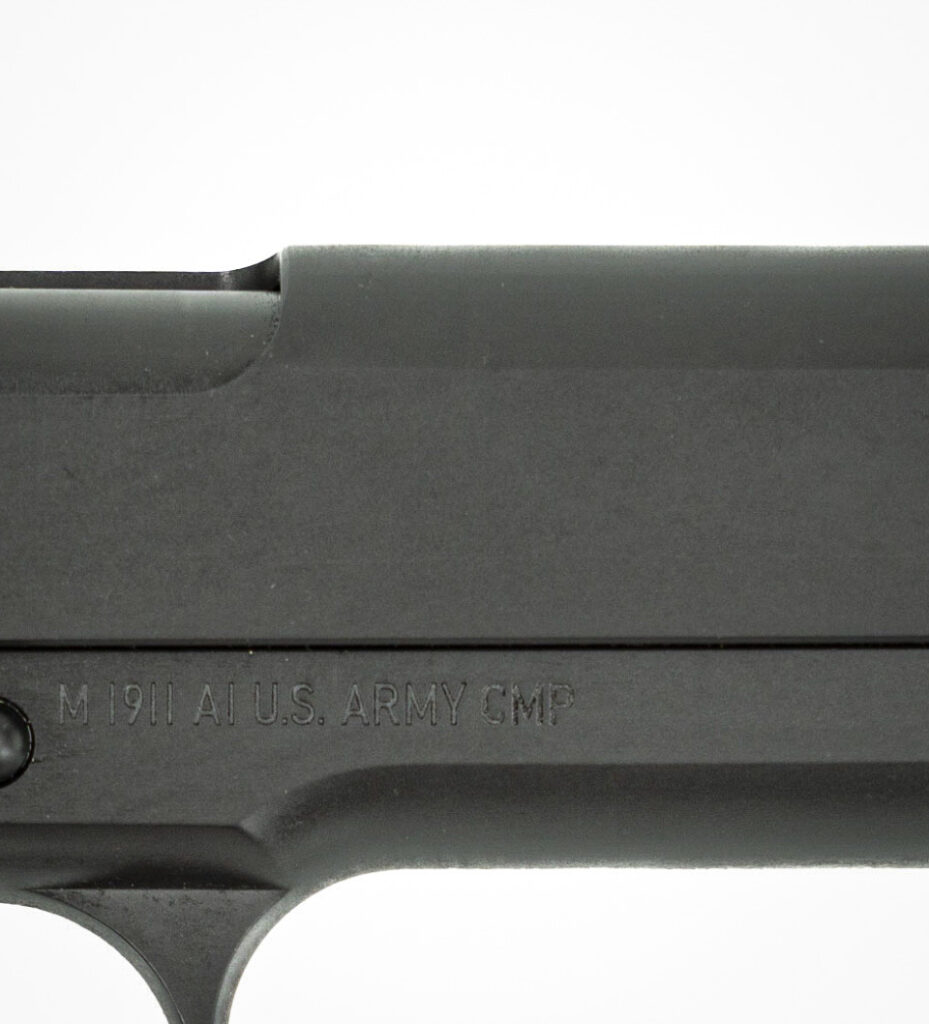
The locking system of the M1911A1 is far stronger than most would make one. When some of the hot 9mm SMG ammo was used in pistols in South America, the only ones that stood up to this were the M1911A1’s that had been made in 9mm.
The single stack magazine works reliably, even in sand. The double-stack single-position feed magazines so popular today have inherent flaws that can get you killed in a gunfight. When a partially empty magazine is dropped, the cartridges can be jarred out of position and jam in the tube, resulting in a failure to feed. The magazine spring needs to be stronger for the double-column magazines, but that makes them hard to load so they are generally left weaker than is desirable for reliable functioning in all conditions. While the magazines for the M1911A1 can be left loaded indefinitely, you cannot leave the double-column magazines loaded like that without risking problems.
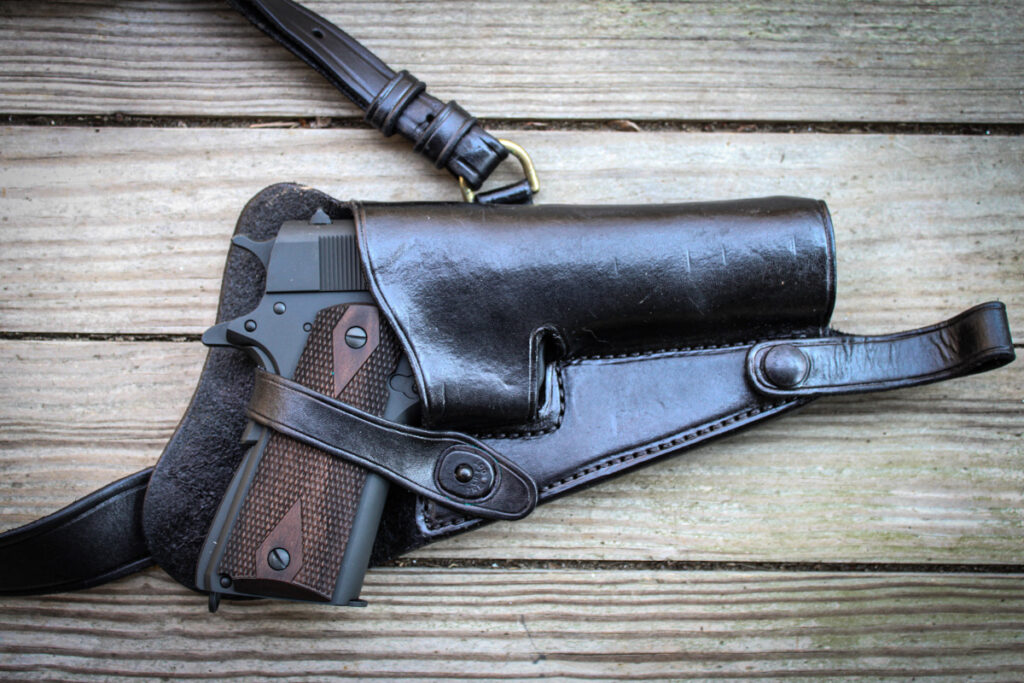
The M1911A1 has few parts, and those are heavy duty. When it comes to maintenance, the 1911A1 is very easy to field strip or even to detail strip.
ERGONOMICS
Unlike many of the current pistols, which look like an obese hippopotamus, the M1911A1 is the optimum size for the round fired. Any bigger or heavier and it would be hard to carry open or concealed. Any smaller and recoil would start to be a problem, eliminating the possibility of true rapid fire.
The safety is in the best possible position for quick use. It’s worth noting that while the gun was intended to be carried cocked-and-locked, the designer, John Browning, thought the grip safety was all that was needed — only adding the manual safety at Army Ordnance’s insistence. His belief was proven true by the Shanghai Police Department before WWII when they pinned the safety in the off position on their hammerless Colt pocket automatics.
The grip angle suits most people and the gun points accurately and easily. Recoil is more of the gun bouncing in your hand than kick. The gun’s size and weight are more than sufficient to tame any recoil forces that might be objectionable.
HOLSTERS
A pistol needs its holster and the M1916 holster issued with the M1911A1 is as perfect as an open carry holster can get. It’s comfortable, protects the gun, and nothing is faster to draw from. There is a leather-covered wood block spacer to position the grip of the gun out where the hand can grab it quickly. To draw quickly, take your thumb and flip the cover flap up then start wrapping your fingers around the grip as you draw, starting with the little finger. When the gun is at the halfway point between the holster and the target, wipe the safety off. It is important to have the tie down thongs fastened before doing this.
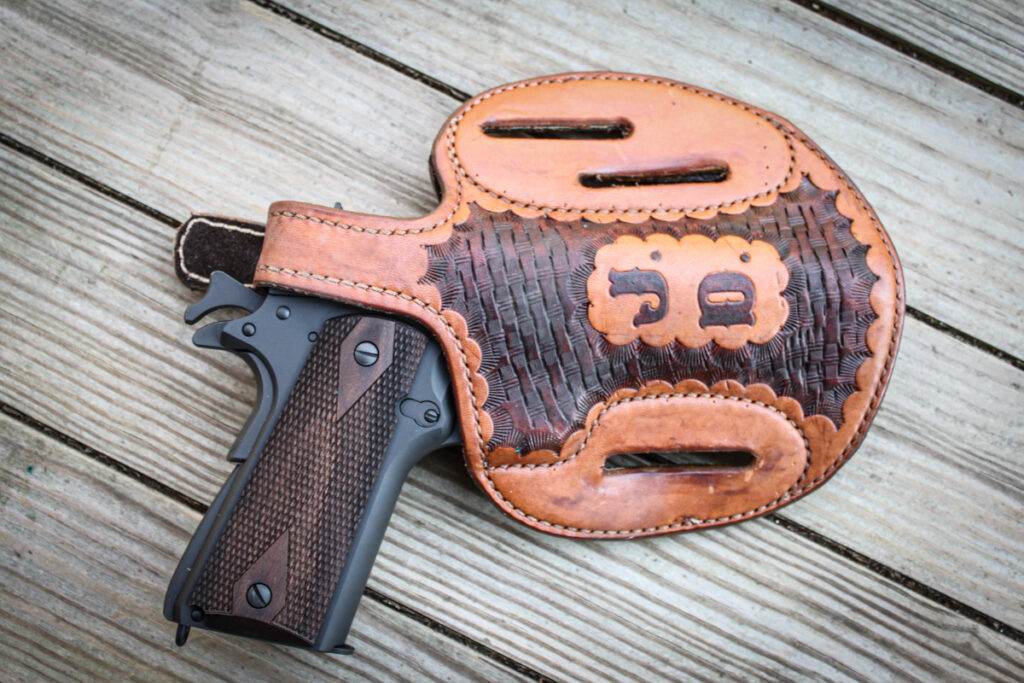
For drawing while driving a vehicle or from a seated position, the military M1942 Tanker holster works well, holding the gun securely while still permitting a fast draw.
For civilian open or concealed carry, the pancake holster can’t be beat. It carries the gun tightly against the body with a quick release thumb-break snap for security. This holster is so comfortable that you can sleep with a M1911A1 in it and even roll over on it without waking. There are times when this is vital.
All of the above holsters can be had from El Paso Saddlery in El Paso, Texas.
POWER AND UTILITY
The 45 ACP cartridge has been a proven threat-stopper on the most fanatical foes on the planet for 113 years. It worked on the Moros in the Philippines and when the mercenaries in the Congo discovered that they could not reliably stop a panga-wielding native with a whole magazine from their 9mm Browning Hi Power pistols, they found that one 45 ACP round would do the job. I have a WWII army training manual that states flatly that the 45 ACP has more power than the 30-06. As for game shooting the old 44-40 killed more game of all types in North America than any other cartridge thanks to the timing of its appearance. The 45ACP is a better killer than the 44-40. Just remember to use FMJ ammo on big bear and moose. You already have a big enough hole, and you need the penetration of a FMJ bullet. The M1911A1 will do any normal job required of a handgun.
CONCLUSION
The Tisas M1911 A1 “ASF” U.S. Army 45 is a fine current production M1911A1 that delivers an impressive amount of quality for a very low price. It’s the best post-war .45 I’ve seen since the Norinco 1911A1 (which the government banned when they forbade Norinco guns being imported so many years ago due to import law violations.) I highly recommend the Tisas, and I prefer it to its higher priced competitors. Not only is it made of forgings that are properly fitted and finished, but it’s also patterned more truly to the original WWII guns which established the G.I. 45’s reputation. This is a contrast to the many modern variations of that design that often look increasingly bizarre. Many of the current crop are also too tightly fitted to be trusted in the gritty world of combat. The M1911A1 is the ultimate handgun, and if I could only have one gun it would be the M1911A1 because unlike a rifle or shotgun, I can always have the pistol on me.
SPECIFICATIONS
| Make | Tisas |
| Model | 1911 A1 “ASF” U.S. Army 45 |
| Action | Colt 70 Series |
| Caliber | 45 ACP |
| Weight (empty) | 2.3 lb. |
| Barrel | 5-inch |
| Magazine Capacity | 7-rd |
| MSRP | $479 |
| URL | tisasusa.com |



